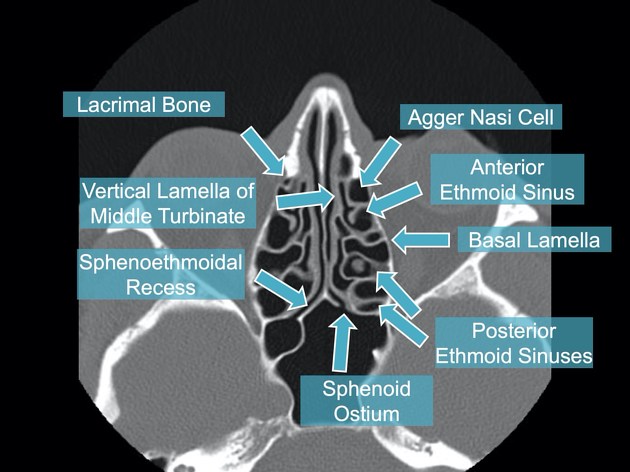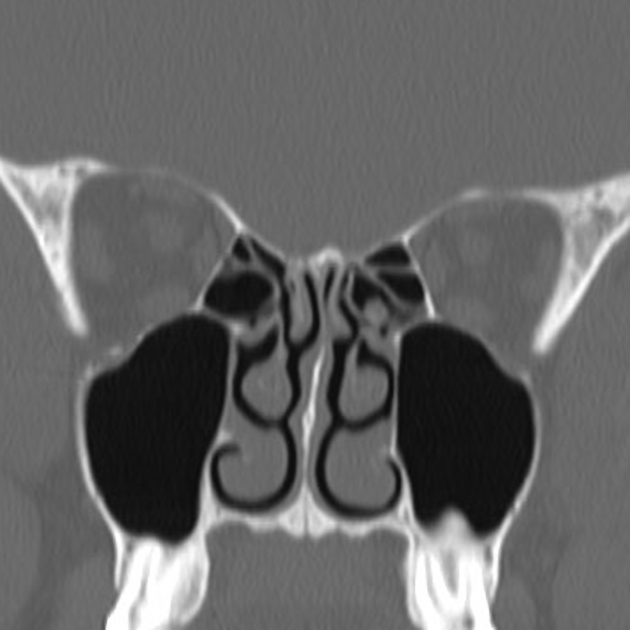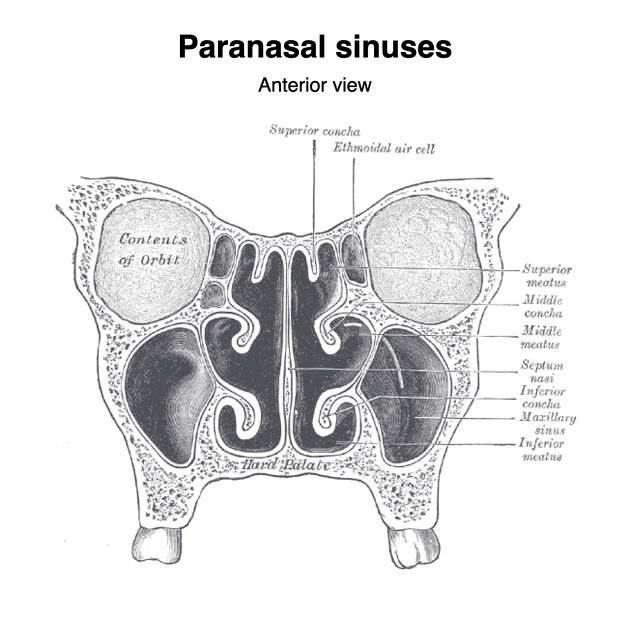Paranasal sinuses
Citation, DOI, disclosures and article data
At the time the article was created Maxime St-Amant had no recorded disclosures.
View Maxime St-Amant's current disclosuresAt the time the article was last revised Abdus Sattar had no financial relationships to ineligible companies to disclose.
View Abdus Sattar's current disclosures- Paranasal sinus
The paranasal sinuses usually consist of four paired air-filled spaces. They have several functions of which reducing the weight of the head is the most important. Other functions are air humidification and aiding in voice resonance. They are named for the facial bones in which they are located:
On this page:
Variant anatomy
The paranasal sinuses are subject to marked variation between individuals and between sides in the same individual, regarding size (aeration) and bony septations.
total paranasal sinus agenesis - very rare 1
isolated frontal sinus agenesis - common
aerated crista galli
anterior clinoid process pneumatization
-
protrusion and/or dehiscence of
optic nerve
maxillary nerves
vidian nerves
-
pneumatization of
anterior clinoid processes
sphenoid sinus septa attachment on the bony canal of the optic nerve
variable depth of the olfactory fossa (Keros classification)
Radiographic features
Plain radiograph
Basic radiographic features are
MRI
Normal mucosa of the paranasal sinuses appear hyperintense on T2-weighted images 4.
Development
The maxillary and ethmoidal sinuses are the first to develop, followed by frontal and sphenoidal sinuses 3.
Quiz questions
References
- 1. Korkmaz H & Korkmaz M. Total Aplasia of the Paranasal Sinuses. Allergy Rhinol (Providence). 2013;4(2):e105-9. doi:10.2500/ar.2013.4.0056 - Pubmed
- 2. Reddy U & Dev B. Pictorial Essay: Anatomical Variations of Paranasal Sinuses on Multidetector Computed Tomography-How Does It Help FESS Surgeons? Indian J Radiol Imaging. 2012;22(4):317-24. doi:10.4103/0971-3026.111486 - Pubmed
- 3. Courey M & Pletcher S. Upper Airway Disorders. Murray and Nadel's Textbook of Respiratory Medicine. 2016;:877-896.e5. doi:10.1016/b978-1-4557-3383-5.00049-x
- 4. Stephanie Ryan, Michelle McNicholas, Stephen J. Eustace. Anatomy for Diagnostic Imaging. (2011) ISBN: 9780702029714 - Google Books
Incoming Links
- Sinonasal mucosal melanoma
- Supra bulla frontal cell
- Aneurysmal bone cyst
- Pneumosinus dilatans
- Juvenile nasopharyngeal angiofibroma
- Frontal sinus
- Accessory maxillary ostium
- Oncocytic sinonasal papilloma
- Sinonasal disease
- Cocaine-induced midline destructive lesion
- Intrasinus calcification
- Respiratory tract
- Superior cervical ganglion
- Supra agger cell
- Supra agger frontal cell
- Sinonasal undifferentiated carcinoma
- Maxillary sinus
- Supraorbital air cells
- Pterygopalatine ganglion
- Sinonasal polyposis
- Paranasal sinuses and nasal cavity - normal
- Orbit roof subperiosteal collection
- Sinonasal chondrosarcoma
- Accessory maxillary ostium and deviated nasal septum with a spur
- Normal paranasal sinuses x-ray
- Frontal sinus osteoma
- Paranasal sinuses (Gray's illustrations)
- Paranasal sinus development (Gray's illustration)
- Cervical dural arteriovenous fistula
- Normal paranasal sinuses x-ray series
- Langerhans cell histiocytosis of the orbit
- Total aplasia of the paranasal sinuses
- Sinonasal polyposis
- Idiopathic orbital inflammation
- Orbital floor blow-out fracture
- Orbital medial wall and floor blow-out fracture
- Ocular rupture
- Orbitotomy and Graves ophtalmopathy
- Orbitotomy and Graves ophtalmopathy
- Adenoid cystic carcinoma of maxillary sinus
Related articles: Anatomy: Head and neck
- skeleton of the head and neck
-
cranial vault
- scalp (mnemonic)
- fontanelle
-
sutures
- calvarial
- facial
- frontozygomatic suture
- frontomaxillary suture
- frontolacrimal suture
- frontonasal suture
- temporozygomatic suture
- zygomaticomaxillary suture
- parietotemporal suture (parietomastoid suture)
- occipitotemporal suture (occipitomastoid suture)
- sphenofrontal suture
- sphenozygomatic suture
- spheno-occipital suture (not a true suture)
- lacrimomaxillary suture
- nasomaxillary suture
- internasal suture
- basal/internal
- skull landmarks
- frontal bone
- temporal bone
- parietal bone
- occipital bone
- skull base (foramina)
-
facial bones
- midline single bones
- paired bilateral bones
- cervical spine
- hyoid bone
- laryngeal cartilages
-
cranial vault
- muscles of the head and neck
- muscles of the tongue (mnemonic)
- muscles of mastication
-
facial muscles
- epicranius muscle
- circumorbital and palpebral muscles
- nasal muscles
-
buccolabial muscles
- elevators, retractors and evertors of the upper lip
- levator labii superioris alaeque nasalis muscle
- levator labii superioris muscle
- zygomaticus major muscle
- zygomaticus minor muscle
- levator anguli oris muscle
- malaris muscle
- risorius muscle
- depressors, retractors and evertors of the lower lip
- depressor labii inferioris muscle
- depressor anguli oris muscle
- mentalis muscle
- compound sphincter
-
orbicularis oris muscle
- incisivus labii superioris muscle
- incisivus labii inferioris muscle
-
orbicularis oris muscle
- muscle of mastication
- modiolus
- elevators, retractors and evertors of the upper lip
- muscles of the middle ear
- orbital muscles
- muscles of the soft palate
- pharyngeal muscles
- suprahyoid muscles
- infrahyoid muscles
- intrinsic muscles of the larynx
- muscles of the neck
- platysma muscle
- longus colli muscle
- longus capitis muscle
- scalenus anterior muscle
- scalenus medius muscle
- scalenus posterior muscle
- scalenus pleuralis muscle
- sternocleidomastoid muscle
-
suboccipital muscles
- rectus capitis posterior major muscle
- rectus capitis posterior minor muscle
- obliquus capitis superior muscle
- obliquus capitis inferior muscle
- accessory muscles of the neck
- deep cervical fascia
-
deep spaces of the neck
- anterior cervical space
- buccal space
- carotid space
- danger space
- deep cervical fascia
- infratemporal fossa
- masticator space
- parapharyngeal space
- stylomandibular tunnel
- parotid space
- pharyngeal (superficial) mucosal space
- perivertebral space
- posterior cervical space
- pterygopalatine fossa
- retropharyngeal space
- suprasternal space (of Burns)
- visceral space
- surgical triangles of the neck
- orbit
- ear
- paranasal sinuses
- upper respiratory tract
- viscera of the neck
- blood supply of the head and neck
-
arterial supply
-
common carotid artery
- carotid body
- carotid bifurcation
- subclavian artery
- variants
-
common carotid artery
- venous drainage
-
arterial supply
- innervation of the head and neck
-
cranial nerves
- olfactory nerve (CN I)
- optic nerve (CN II)
- oculomotor nerve (CN III)
- trochlear nerve (CN IV)
-
trigeminal nerve (CN V) (mnemonic)
- trigeminal ganglion
- ophthalmic division
- maxillary division
- mandibular division
- abducens nerve (CN VI)
- facial nerve (CN VII)
-
vestibulocochlear nerve (CN VIII)
- vestibular ganglion (Scarpa's ganglion)
- glossopharyngeal nerve (CN IX)
- vagus nerve (CN X)
- (spinal) accessory nerve (CN XI)
- hypoglossal nerve (CN XII)
- parasympathetic ganglia of the head and neck
- cervical sympathetic ganglia
- greater occipital nerve
- third occipital nerve
-
cervical plexus
- muscular branches
- longus capitis
- longus colli
- scalenes
- geniohyoid
- thyrohyoid
-
ansa cervicalis
- omohyoid (superior and inferior bellies separately)
- sternothyroid
- sternohyoid
- phrenic nerve
- contribution to the accessory nerve (CN XI)
- cutaneous branches
- muscular branches
- brachial plexus
- pharyngeal plexus
-
cranial nerves
- lymphatic drainage of the head and neck
- embryological development of the head and neck










 Unable to process the form. Check for errors and try again.
Unable to process the form. Check for errors and try again.